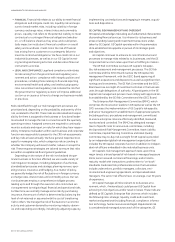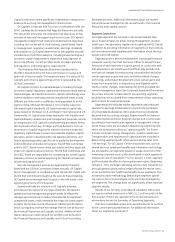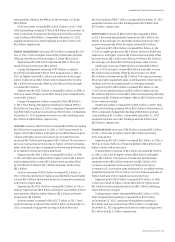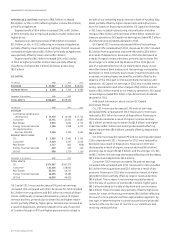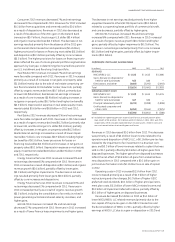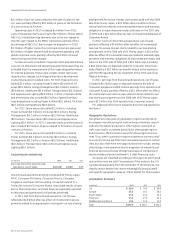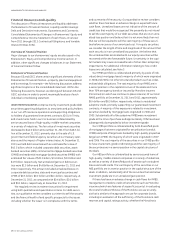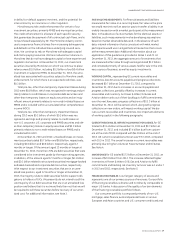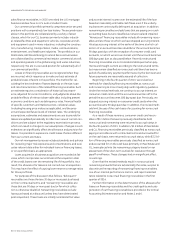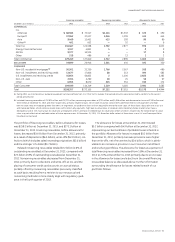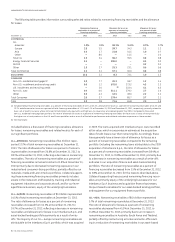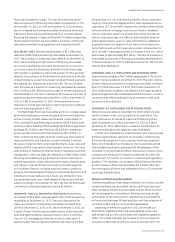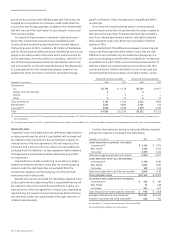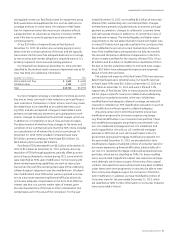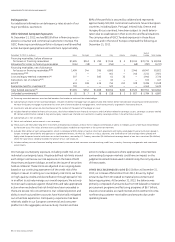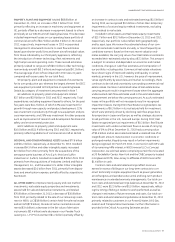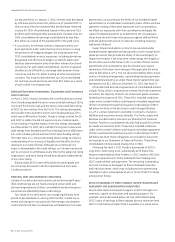GE 2013 Annual Report Download - page 52
Download and view the complete annual report
Please find page 52 of the 2013 GE annual report below. You can navigate through the pages in the report by either clicking on the pages listed below, or by using the keyword search tool below to find specific information within the annual report.’
50 GE 2013 ANNUAL REPORT
sales fi nance receivables. In 2007, we exited the U.S. mortgage
business and we have no U.S. auto or student loans.
Our commercial portfolio primarily comprises senior secured
positions with comparatively low loss history. The secured receiv-
ables in this portfolio are collateralized by a variety of asset
classes, which for our CLL business primarily include: industri-
al-related facilities and equipment, vehicles, corporate aircraft,
and equipment used in many industries, including the construc-
tion, manufacturing, transportation, media, communications,
entertainment, and healthcare industries. The portfolios in our
Real Estate, GECAS and Energy Financial Services businesses
are collateralized by commercial real estate, commercial aircraft
and operating assets in the global energy and water industries,
respectively. We are in a secured position for substantially all of
our commercial portfolio.
Losses on fi nancing receivables are recognized when they
are incurred, which requires us to make our best estimate of
probable losses inherent in the portfolio. The method for cal-
culating the best estimate of losses depends on the size, type
and risk characteristics of the related fi nancing receivable. Such
an estimate requires consideration of historical loss experi-
ence, adjusted for current conditions, and judgments about the
probable effects of relevant observable data, including present
economic conditions such as delinquency rates, fi nancial health
of specifi c customers and market sectors, collateral values
(including housing price indices as applicable), and the pres-
ent and expected future levels of interest rates. The underlying
assumptions, estimates and assessments we use to provide for
losses are updated periodically to refl ect our view of current con-
ditions and are subject to the regulatory examinations process,
which can result in changes to our assumptions. Changes in such
estimates can signifi cantly affect the allowance and provision for
losses. It is possible to experience credit losses that are different
from our current estimates.
Our risk management process includes standards and policies
for reviewing major risk exposures and concentrations, and eval-
uates relevant data either for individual loans or fi nancing leases,
or on a portfolio basis, as appropriate.
Loans acquired in a business acquisition are recorded at fair
value, which incorporates our estimate at the acquisition date
of the credit losses over the remaining life of the portfolio. As a
result, the allowance for losses is not carried over at acquisition.
This may have the effect of causing lower reserve coverage ratios
for those portfolios.
For purposes of the discussion that follows, “delinquent”
receivables are those that are 30 days or more past due based
on their contractual terms, and “nonearning” receivables are
those that are 90 days or more past due (or for which collec-
tion is otherwise doubtful). Nonearning receivables exclude
loans purchased at a discount (unless they have deteriorated
post acquisition). These loans are initially recorded at fair value
and accrete interest income over the estimated life of the loan
based on reasonably estimable cash fl ows even if the underly-
ing loans are contractually delinquent at acquisition. In addition,
nonearning receivables exclude loans that are paying on a cash
accounting basis but are classifi ed as nonaccrual and impaired.
“Nonaccrual” fi nancing receivables include all nonearning receiv-
ables and are those on which we have stopped accruing interest.
We stop accruing interest at the earlier of the time at which col-
lection of an account becomes doubtful or the account becomes
90 days past due, with the exception of consumer credit card
accounts, on which we accrue interest until the account becomes
180 days past due, as discussed below. Recently restructured
fi nancing receivables are not considered delinquent when pay-
ments are brought current according to the restructured terms,
but may remain classifi ed as nonaccrual until there has been a
period of satisfactory payment performance by the borrower and
future payments are reasonably assured of collection.
Beginning in the fourth quarter of 2013, we revised our
methods for classifying fi nancing receivables as nonaccrual
and nonearning to more closely align with regulatory guidance.
Under the revised methods, we continue to accrue interest on
consumer credit cards until the accounts are written off in the
period the account becomes 180 days past due. Previously, we
stopped accruing interest on consumer credit cards when the
account became 90 days past due. In addition, the revised meth-
ods limit the use of the cash basis of accounting for nonaccrual
fi nancing receivables.
As a result of these revisions, consumer credit card receiv-
ables of $1.1 billion that were previously classifi ed as both
nonaccrual and nonearning were returned to accrual status in
the fourth quarter of 2013. In addition, $1.5 billion of Real Estate
and CLL fi nancing receivables previously classifi ed as nonaccrual,
paying in accordance with contractual terms and accounted for
on the cash basis, were returned to accrual status, while $2.2 bil-
lion of fi nancing receivables previously classifi ed as nonaccrual
and accounted for on the cash basis (primarily in Real Estate and
CLL) were placed into the nonearning category based on our
assessment of the short-term outlook for resolution through
payoff or refi nance. These changes had an insignifi cant effect
on earnings.
Given that the revised methods result in nonaccrual and
nonearning amounts that are substantially the same, we plan to
discontinue the reporting of nonearning fi nancing receivables,
one of our internal performance metrics, and report selected
ratios related to nonaccrual fi nancing receivables in the fi rst
quarter of 2014.
Further information on the determination of the allowance for
losses on fi nancing receivables and the credit quality and cate-
gorization of our fi nancing receivables is provided in the Critical
Accounting Estimates section and Notes 1 and 6.


